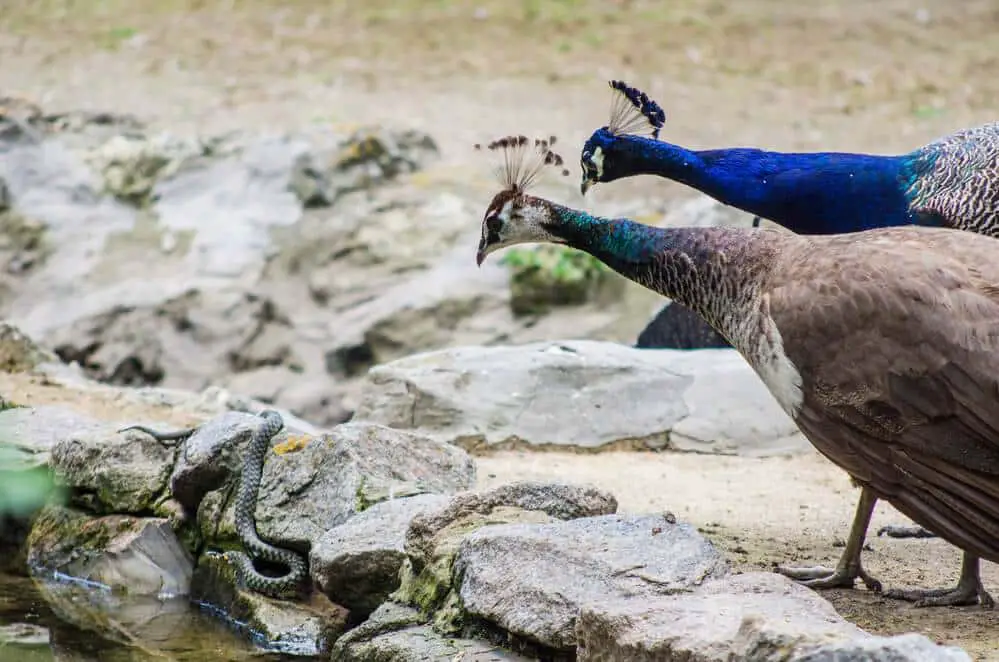Stunning feathers and magnificent appearance – that’s what comes to mind when we think about Peacocks. But are these beautiful birds capable of eating snakes? Let’s dive right in and explore!
So, peacocks do eat snakes, but they are not an important part of their diet. Peacocks are omnivores and consume a variety of food sources including plant-based items like seeds, flower buds, tender shoots of crops, and fruits, as well as animal-based sources like worms, reptiles, and small mammals.
While they have been known to consume small snakes that are around 7.87 inches in size, snakes are not a primary component of their diet.

Interesting Fact: In Sanskrit, the term used for Peacock is “Mayura” which literally means the killer of snakes.
The Peacock Diet And Feeding Habit: Quick Overview
| Feeding Habit: | Omnivorous |
| Primary Foods: | Seeds, crops, fruits, flower buds, reptiles, arthropods, worms, and small mammals |
| Feeding Analysis: | Vegetable matter comprises 91% of intake |
| Foraging Habitat: | Cultivated Fields And Fallow Lands |
| Foraging Style: | Forages in small groups, capture food from the ground; fights other peacocks for good morsels |
| Drinking Habit: | An hour post sunrise, and at dusk before returning to their resting spots |
Peacock vs. Snakes: How Do They Eat Snakes?
Peacocks aren’t just all about showing off their stunning plumage. They’re also skilled predators when it comes to hunting snakes. But how exactly do they catch and consume them? Let’s find out.
Beaks and Talons: A Deadly Combo
Peacocks use their sharp beaks and talons to grab and kill snakes. They can strike with precision, targeting the snake’s head to deliver a swift, fatal blow.
Taking Flight to Strike
Another advantage peacocks have is their ability to fly. Attacking from above, they can swoop down on unsuspecting snakes, avoiding the risk of being bitten.
Size Matters: Snakes vs. Peacocks
However, not all snakes are easy prey for peacocks. The size and species of the snake play a crucial role in determining the outcome of these encounters. Peacocks are more likely to hunt smaller, non-venomous snakes rather than larger, potentially dangerous ones.
Practice Makes Perfect
A peacock’s success in hunting snakes also depends on its experience and skill as a hunter. As with many predators, practice is key. Over time, peacocks become more adept at spotting, stalking, and capturing their slithery prey.
Related Read: What Sound Does A Peacock Make?
Peacock vs. Snake Video
Why Do Peacocks Eat Snakes: Revealing The Mystery
1. Adapting to Their Environment:
Peacocks are native to Asia, where they inhabit a variety of environments, including forests, grasslands, and even villages. In these habitats, snakes are a common sight.
Over time, peacocks have adapted to their surroundings and learned to take advantage of the available food sources, which includes these slithering reptiles.
2. Balanced Diet and Nutrition:
Peacocks, like many birds, have a diverse diet. They’re omnivorous, which means they consume both plant and animal matter.
Eating snakes helps peacocks maintain a balanced diet by providing essential nutrients such as protein and fat. These nutrients are important for their overall health, growth, and reproductive success.
3. Opportunistic Feeding:
In the wild, survival is all about making the most of what’s available. For peacocks, this means not being picky about their prey.
Snakes might not be their primary food source, but they’re a valuable addition to their menu when other food options are scarce.
4. Completing The Ecological Cycle:
Lastly, by preying on snakes, peacocks play a critical role in maintaining ecological balance. They help control snake populations, keeping them in check and preventing overpopulation. This, in turn, benefits the overall ecosystem where they reside.
How Often Do Peacocks Dine On Snakes?
While peacocks do eat snakes, it’s not an everyday occurrence. Snakes make up only a small portion of their diet.
A study conducted on the habitat usage and food habits of Indian peafowl in the Western Ghats revealed that approximately 91% of their diet consisted of vegetable matter.
So in a nutshell, Peacocks can be considered opportunistic feeders when it comes to their snake-eating habits. While they do eat snakes, it’s not an everyday occurrence.
These elegant birds won’t pass up the chance to indulge in a snake-based snack if the opportunity presents itself, but they won’t actively seek them out on a daily basis.
The primary reason for this infrequency is the peacock’s diverse diet. As omnivores, they enjoy eating a variety of plant and animal matter, such as seeds, insects, small mammals, and even amphibians. This wide array of food choices means that snakes don’t always make it to the top of their menu.
Another factor that plays a role in the peacock’s snake-dining frequency is the season. In certain times of the year, when food resources are more abundant, peacocks might prefer to dine on other, more easily accessible options. Snakes, on the other hand, may be more prevalent during specific seasons, increasing the likelihood of a peacock-snake encounter.
Finally, the availability of snakes in a peacock’s habitat can also impact how often they feast on them. In regions where snakes are more abundant, peacocks are more likely to encounter and consume them. Conversely, in areas where snake populations are sparse, peacocks will focus on other food sources that are more readily available.
In essence, although peacocks are known to dine on snakes, it’s not a staple in their diet. They’re quite the versatile and adaptable birds, making the most of the resources available to them.
Is Peacock Immune To Snake Venom?
Did you know that historically in India, peacocks were utilized by royalty to protect their palaces from cobras? The peacocks’ natural behavior of attacking snakes, made them effective guardians against these venomous creatures.
But what about the effect of the venom of the snakes? Are peacocks immune to snake venom? While there isn’t a definitive, well-documented answer to this question, we can lean towards saying “yes,” and there are two compelling reasons to support this notion.
Firstly, most animals who are capable of eating snakes are also immune to venom. Examples include honey badger, opossum, and hedgehog.
Secondly, in Indian medicine, the peacock feathers are used in the form of ash or extract to treat snake bite related problems. And according to a study, the water extract from peacock feathers has the ability to inhibit specific enzymes (hyaluronidase and proteases) found in snake venom and thus, it’s helpful in neutralizing local tissue damage caused by snake venom.
Peacock vs. Snake: Who Will Win In Fight?
| Peacock | Snake |
| Size: 3.25 – 3.75 ft in length (bill to tail length) | Size: Varies greatly, from 4.1 inches to 30 feet |
| Weight: 9-13 lbs (4-6 kg) | Weight: Can range from 0.02 oz (0.6 g) to over 550 lbs (249 kg) |
| Speed: Up to 10 mph (16 km/h) on land | Speed: Up to 18 mph (29 km/hr) for some species |
| Primary Attacking Tools: Sharp beak and talons | Primary Attacking Tools: Venom (for venomous species) and constriction (for constrictors) |
| Defensive tactics: Plumage display and flight | Defensive tactics: Camouflage, hissing, and striking |
Now that we have a basic understanding of these two fascinating creatures, let’s discuss how they might fare against each other in a hypothetical battle.
Strike from Above: Peacock’s Advantage
One of the peacock’s most significant advantages is its ability to fly. By attacking from a safe distance, the peacock can avoid the risk of being bitten or constricted.
Smart Camouflage: The Snake’s Strategy
Snakes, on the other hand, are masters of camouflage and stealth. Their ability to blend into their environment can help them avoid detection and launch surprise attacks. For venomous species, a single bite can be deadly, while constrictors rely on their powerful coils to subdue their prey.
Size Matters: The Role of Proportions
Snakes can vary greatly in size, and this will play a crucial role in determining the outcome of a fight. A smaller snake is less likely to pose a significant threat to a peacock, while a larger snake may have the upper hand due to its size and strength.
The Verdict:
It’s challenging to determine a clear winner in a hypothetical peacock versus snake battle, as the outcome largely depends on various factors such as size and species.
In a face-off between a peacock and a snake, the element of surprise is crucial. If the peacock can detect the snake and attack first, it may be able to overpower and kill the snake. However, if the snake can launch a surprise attack, the tables could turn in its favor.

